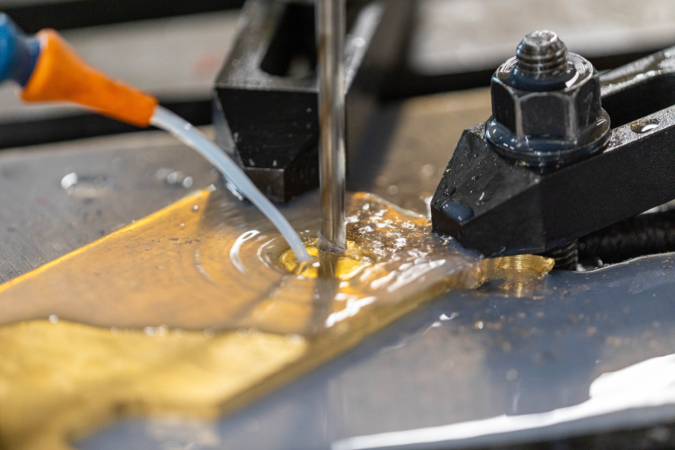AWE requests change to discharge permit
AWE has applied to the Environmental Agency to increase an environmental permit limit relating to the discharge of radioactive material.
The permit in question is the radioactive substances activity permit made under the Environmental Permitting Regulations 2016.
This change seeks to increase the Aldermaston site limit for volatile beta discharges from 4.4 megaBecquerels to what it previously was in the early 1990’s, 100 megaBecquerels. The public dose impact of this is very small at 0.16 microsieverts.
Peter Caddock AWE Group Leader Environment said: “In my role I hold the business accountable for environmental protection, pollution, prevention and the wider sustainability agenda.
“This important application for a variation to our environmental permit supports a programme which is important for our national nuclear forensic capability.
At AWE as a responsible business in everything that we do, we need to demonstrate that our activities have minimal impact on the environment and local community. In doing so we have completed assessment work to demonstrate that this activity has minimal impact to members of the public.”
This will allow AWE to deliver a nuclear forensics capability with only a very small dose impact to members of the public of 0.16 microsieverts.
To put this in context, the average annual dose to a member of the public from all sources of environmental radiation is 2300 microsieverts.
AWE applied for the permit increase to support a UK nuclear forensics capability. Since 2005, AWE has participated in exercises with key allies by analysing a small number of radioactive simulant samples (typically around 10) each year. These exercises enable the participants to rehearse and validate their radiochemical and radiometrology methods.
You can read the Environment Agency application advertisement here.
Table 1 – Putting doses into context
|
Activity |
Dose in microsieverts (µSv) |
|
135g bag of Brazil nuts if eaten |
5 µSv |
|
Chest x-ray |
20 µSv |
|
Transatlantic flight |
70 µSv |
|
CT scan of the head |
1400 µSv |
|
UK average annual radiation dose from environmental sources |
2300 µSv |
|
AWE Key Performance Indicator for Maximum Individual Dose |
4000 µSv |
|
CT scan of the chest |
6600 µSv |
|
Average annual radon dose living in Cornwall |
7800 µSv |
|
AWE Company Annual Dose Limit |
10000 µSv |
|
Whole body CT scan |
10000 µSv |
|
UK Annual Dose Limit for Nuclear Workers |
20000 µSv |
Glossary of terms –
BAT Best Available Techniques. BAT is the process whereby an operator selects the management option and the practices applied that best meet the full range of relevant health, safety, environmental and security (including safeguards) principles and criteria, taking into account all relevant factors, eg social and economic considerations.
Becquerel (Bq) Metric unit of radioactivity equal to one disintegration per second
MegaBecquerel One million Becquerels
Sievert (Sv) Metric unit of dose and a measure of radiation dose received by a person
μSv y-1 One millionth of a Sievert per year
Q&A’s
- What is an environmental permit?
The environmental permit allows AWE to receive and dispose of radioactive material on or from the site. The permit is issued under the provisions of the Environmental Permitting (England and Wales) Regulations 2016. Those Regulations include the control of radioactive material to which conditions and limits are applied. Within the conditions and limits the permit allows materials that are produced during AWE’s operations to be discharged to the environment as aqueous or gaseous materials or transferred as solid material to other national facilities permitted to treat and dispose of the material.
- How are these permits regulated?
The permits are regulated by the Environment Agency.
- What is dose?
We measure a person’s exposure to ionising radiation in terms of effective dose. The unit of dose is the Sievert (Sv); however 1 Sv is a very large dose, for this reason doses are normally given in milliSieverts (mSv) or microSieverts (µSv).
1 Sv = 1000 mSv = 1000000 µSv
On average, a member of the UK public will receive a dose of 2.3 milliSieverts (2300 microSieverts) per year from environmental sources of radiation.
- What type of radioactive material is released?
The radioactive material released comprises isotopes of the noble gas xenon (as well as krypton, bromine) and volatile gases of other radioactive isotopes including iodine, technetium, ruthenium. There are some other minor constituents that each represent less than <0.01% of the activity discharged.
- What are volatile beta emitters?
Volatile beta emitters are materials which are radioactive and vaporise or evaporate quickly. Beta radiation relates to radioactive decay through the emission of electrons.
- Will local residents receive more radiation as a result of this change?
The impact to local residents will be very small, an increase in a dose (of order 0.16 microSieverts per year). To put this in context the average annual dose to a member of the public from all sources of environmental radiation is 2300 microSieverts.
- How is the radioactivity released?
The laboratory processes that are used to prepare the samples for analysis have been optimised in order to minimise the amounts of radioactivity that requires disposal or discharge to the environment. The radioactive isotopes that are released from the laboratories involved with this work are mainly short-lived and are released via stacks to disperse the discharge and mitigate the impact to humans and the environment.



